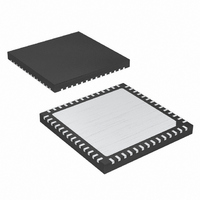MAX19711ETN+T Maxim Integrated Products, MAX19711ETN+T Datasheet - Page 33

MAX19711ETN+T
Manufacturer Part Number
MAX19711ETN+T
Description
IC ANLG FRNT END 56-TQFN
Manufacturer
Maxim Integrated Products
Datasheet
1.MAX19711ETN.pdf
(36 pages)
Specifications of MAX19711ETN+T
Number Of Bits
10
Number Of Channels
2
Power (watts)
37.5mW
Voltage - Supply, Analog
3V
Voltage - Supply, Digital
3V
Package / Case
56-TQFN Exposed Pad
Lead Free Status / RoHS Status
Lead free / RoHS Compliant
Integral nonlinearity is the deviation of the values on an
actual transfer function from a straight line. This straight
line can be either a best-straight-line fit or a line drawn
between the end points of the transfer function, once
offset and gain errors have been nullified. The static lin-
earity parameters for the device are measured using
the best-straight-line fit (DAC Figure 15a).
Differential nonlinearity is the difference between an
actual step width and the ideal value of 1 LSB. A DNL
error specification of less than 1 LSB guarantees no
missing codes (ADC) and a monotonic transfer function
(ADC and DAC) (DAC Figure 15b).
Ideally, the midscale transition occurs at 0.5 LSB above
midscale. The offset error is the amount of deviation
between the measured transition point and the ideal
transition point.
Offset error (Figure 15a) is the difference between the
ideal and actual offset point. The offset point is the out-
put value when the digital input is midscale. This error
affects all codes by the same amount and usually can
be compensated by trimming.
Ideally, the ADC full-scale transition occurs at 1.5 LSB
below full scale. The gain error is the amount of devia-
tion between the measured transition point and the
ideal transition point with the offset error removed.
Figure 16 shows the aperture jitter (t
sample-to-sample variation in the aperture delay.
Aperture delay (t
rising edge of the sampling clock and the instant when
an actual sample is taken (Figure 16).
For a waveform perfectly reconstructed from digital
samples, the theoretical maximum SNR is the ratio of
the full-scale analog input (RMS value) to the RMS
quantization error (residual error) and results directly
from the ADC’s resolution (N bits):
ADC and DAC Static Parameter Definitions
Dynamic Parameter Definitions
ADC Dynamic Parameter Definitions
SNR(max) = 6.02 x N + 1.76 (in dB)
AD
______________________________________________________________________________________
) is the time defined between the
Differential Nonlinearity (DNL)
Signal-to-Noise Ratio (SNR)
Integral Nonlinearity (INL)
ADC Offset Error
DAC Offset Error
AJ
ADC Gain Error
Aperture Delay
Aperture Jitter
), which is the
10-Bit, 11Msps, Full-Duplex
Figure 15b. Differential Nonlinearity
Figure 16. T/H Aperture Timing
Figure 15a. Integral Nonlinearity
DATA (T/H)
SAMPLED
ANALOG
6
5
4
3
2
1
0
INPUT
000
CLK
T/H
Analog Front-End
7
6
5
4
3
2
1
0
000
t
AD
001
TRACK
001
DIGITAL INPUT CODE
010
010
DIGITAL INPUT CODE
AT STEP
001 (0.25 LSB)
1 LSB
011
011
DIFFERENTIAL
LINEARITY ERROR (+0.25 LSB)
t
HOLD
AJ
DIFFERENTIAL LINEARITY
ERROR (-0.25 LSB)
100
100
AT STEP
011 (0.5 LSB)
101
101
110
1 LSB
TRACK
111
33







